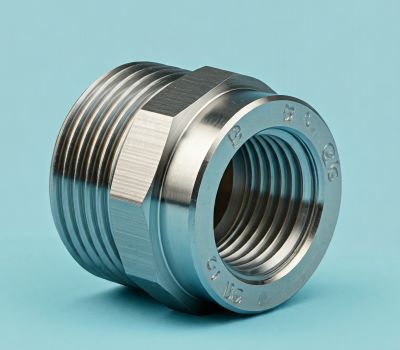JIC fittings are specifically designed for high-pressure applications, offering a secure and leak-proof connection. They are commonly found in various industries, including automotive, aerospace, construction, and manufacturing. Understanding the intricacies of JIC fitting thread sizes is crucial for technicians, engineers, and anyone working with fluid power systems.
Understanding JIC Fitting Thread Sizes
What Are JIC Fitting Threads?
JIC fittings employ a tapered pipe thread, which ensures a tight seal as the fittings are tightened. The thread profile is specifically designed to withstand high pressures and vibrations.
How Thread Size Affects Connection and Performance
The integrity of the connection and fitting compatibility are determined by the thread size. An improper thread size may cause:
➡️ Leaks: A loose fit can lead to fluid leakage, compromising system efficiency and potentially causing safety hazards.
➡️ Damage: Forcing a mismatched fitting can damage the threads, rendering the fitting unusable.
➡️ Reduced Performance: A poor connection can restrict fluid flow, impacting the overall performance of the system.
Common Applications of JIC Fittings
JIC fittings are widely used in:
➡️ Hydraulic power units
➡️ Mobile equipment
➡️ Industrial machinery
➡️ Automotive systems
Tools Needed for Measuring JIC Thread Sizes
Essential Tools for Accurate Measurement
To accurately measure JIC thread sizes, you’ll need the following tools:
➡️ Thread gauge: This tool measures the major diameter, minor diameter, and thread pitch.
➡️ Micrometer: Used to measure the precise dimensions of the thread.
➡️ Caliper: For general measurements and verifying the overall size of the fitting.
Tips for Choosing the Right Measuring Equipment
➡️ Accuracy: Ensure your tools are calibrated and accurate to avoid measurement errors.
➡️ Compatibility: Choose tools that are compatible with JIC thread profiles.
➡️ Ease of Use: Select tools that are easy to handle and provide clear readings.
How to Measure JIC Fitting Thread Sizes
Step-by-Step Guide to Thread Identification
1. Clean the Thread: Remove any dirt or debris that may obstruct the measurement.
2. Determine the Thread Type: Verify that the thread is a JIC tapered pipe thread.
3. Determine the Major Diameter: Determine the thread’s biggest diameter using a micrometer.
4. Measure the Minor Diameter: Use a micrometer to measure the smallest diameter of the thread.
5. Measure the Thread Pitch: Use a thread gauge to determine the distance between adjacent threads.
Avoiding Common Mistakes During Measurement
➡️ Incorrect Tool Usage: Ensure you are using the right tools and techniques for accurate measurements.
➡️ Measurement Errors: Double-check your measurements to avoid mistakes.
➡️ Ignoring Thread Direction: Pay attention to the thread direction (right-hand or left-hand).
Standard JIC Thread Sizes and Their Specifications
Overview of Standard JIC Thread Dimensions
JIC fittings are available in various standard thread sizes, including:
➡️ 1/4-18 NPTF
➡️ 3/8-24 NPTF
➡️ 1/2-20 NPTF
➡️ 3/4-16 NPTF
➡️ 1-14 NPTF
Key Industry Standards for JIC Threads
➡️ SAE J514: This standard outlines the specifications for JIC fittings, including thread dimensions.
➡️ ISO 11926: This international standard covers hydraulic hose fittings and couplings, including JIC fittings.
Tips for Selecting the Right JIC Fitting Thread Size
Matching Thread Sizes to Application Needs
When selecting JIC fittings, consider the following factors:
➡️ Pressure Rating: Select fittings whose pressure rating is higher than your system’s maximum operating pressure.
➡️ Flow Rate: Ensure the fitting can handle the required flow rate without causing excessive pressure drop.
➡️ Fluid Compatibility: Select fittings made from materials compatible with the fluid being used.
Factors to Consider When Choosing Thread Sizes
➡️ System Pressure: Higher pressure applications may require larger thread sizes to withstand the force.
➡️ Fluid Viscosity: Viscous fluids may require larger fittings to reduce pressure drop.
➡️ Flow Rate: Higher flow rates necessitate larger fittings to minimize restrictions.
Troubleshooting Connection Issues with JIC Fittings
Identifying and Resolving Common Thread Mismatches
If you’re experiencing connection issues with JIC fittings, it’s essential to identify the root cause. Common problems include:
➡️ Incorrect Thread Size: Double-check the thread size of both the fitting and the pipe or hose.
➡️ Cross-Threading: This occurs when the threads are not aligned properly, leading to a poor connection.
➡️ Damaged Threads: Inspect the threads for any damage, such as burrs or chips, that could hinder a proper connection.
Ensuring a Leak-Free Seal with Proper Thread Alignment
To achieve a leak-free seal, follow these best practices:
➡️ Clean Threads: Remove any dirt, debris, or old sealant from the threads.
➡️ Apply Thread Sealant: Use a high-quality thread sealant to ensure a tight seal.
➡️ Hand-Tighten: Tighten the fitting by hand until it makes initial contact.
➡️ Use a Wrench: Use a wrench to tighten the fitting to the specified torque.
➡️ Avoid Over-Tightening: Over-tightening can damage the threads and lead to leaks.
Maintaining JIC Fitting Thread Integrity
Best Practices for Long-Term Thread Durability
To prolong the life of JIC fittings and their threads, consider these tips:
➡️ Regular Inspection: Visually inspect fittings for signs of wear, damage, or leaks.
➡️ Proper Torque: Tighten fittings to the recommended torque to avoid over-tightening.
➡️ Avoid Impact Forces: Avoid subjecting fittings to sudden impact forces, which can damage the threads.
➡️ Protect from Corrosion: Use corrosion-resistant materials and protective coatings to prevent damage.
The Importance of Regular Inspections and Maintenance
Regular inspection and maintenance of JIC fittings are crucial for ensuring system reliability and safety. By following these guidelines, you can prevent costly downtime and potential accidents.
Conclusion
Here are the key takeaways for perfect JIC connections:
➡️ Thread Size Accuracy: Prioritize accurate thread size measurement to ensure proper fitting compatibility.
➡️ Tool Selection: Use appropriate tools for precise measurements and efficient installation.
➡️ Thread Preparation: Clean threads and apply thread sealant for a secure connection.
➡️ Proper Torque: Tighten fittings to the recommended torque to avoid damage.
➡️ Regular Inspection: Conduct regular inspections to identify and address potential issues.
By adhering to these principles, you can achieve perfect JIC connections and optimize the performance of your fluid power systems.
Post time: Nov-19-2024


